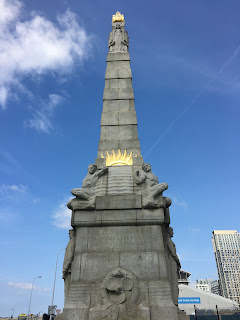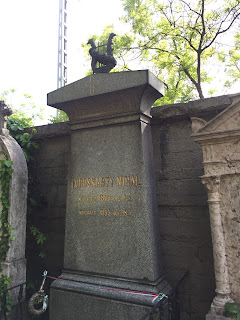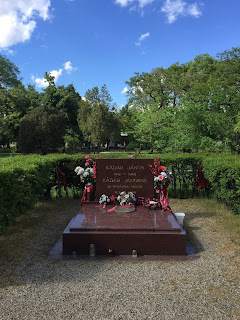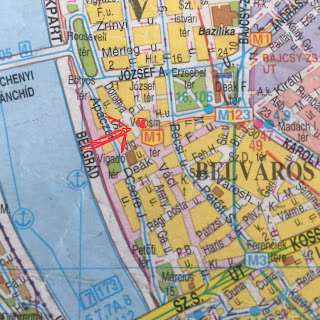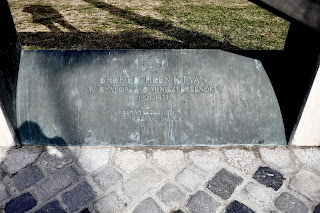I came across this statue in Baden Baden, in the Lichtenauer Allee. It is the work of Joseph von Kopf and was erected in 1892. It is dedicated to Princess Augusta Marie Louise Katherina of Saxe-Weimar-Eisenach, whose father was Grand Duke of Saxe-Weimar-Eisenach and whose mother was the daughter of Paul I of Russia. Augusta's mother was described by Goethe as "one of the best and most significant women of her time", and she ensured that her daughter Augusta had a very good education. Whether this fitted Augusta well for her subsequent life is debatable. Perhaps if she had been less well-educated, she might have been happier, as she might have thought less deeply about the political events going on around her and their consequences.
Be that as it may, having been thoroughly educated, Augusta married in 1829. She was still only 18, and her husband Wilhelm Friedrich Ludwig, son of the King of Prussia was 14 years older than her. She had met him for the first time three years earlier, when she was only 15 years old. At that time, Wilhelm was deeply involved with Princess Eliza Radziwil, who, coincidentally, later died at a spa, (not a great advertisement for taking a so-called cure, but at least it wasn't Baden Baden).
Presumably Princess Radziwil was related to Stanislaw Radziwil, who married Jackie Kennedy's sister after meeting her at a dinner party in London on 26 March, 1957. Radziwil attended the dinner party with his second wife, an heiress called Grace Kolin, Jackie Kennedy's sister Lee attended with her husband, whose name was Michael Canfield, (supposedly the illegitimate son of the Duke of Kent and an American who was called Kiki Preston, but born Alice Gwynn, the grand-daughter of the redoubtable Mrs Cornelius Vanderbilt), and a couple called Lord and Lady Dudley. What a dinner party it must have been - each of the couples divorced following it and Canfield married Lady Dudley, Lord Dudley married Grace Kolin and Stanislaw Radziwil married Jackie Kennedy's sister Lee.
Whatever Eliza Radziwil's social connections then or later, they did not satisfy Wilhelm's family. Supposedly, at some stage in the distant past the Radziwils had sullied themselves by parting with cash in exchange for their princely title. My dear, they were practically trade. Even though it was not Wilhelm but his older brother who was the Crown Prince, Wilhelm was still expected to marry someone whose claim to nobility was of such a level that their children would be considered suitable to take the throne if the need arose. Thus it was that Wilhelm was persuaded by his father to marry Augusta, even though, as he wrote to his sister, while he found Augusta nice and clever, his true and only love was Eliza.
Augusta by Carl Joseph Begas, 1838
The marriage went ahead - (after all, love was not really the central element in royal arranged marriages at the time) - and Augusta became part of the Prussian court. She seems to have been very interested in politics and possibly slightly better at it than her husband. In 1847, following crop failures and widespread hunger, his older brother refused to liberalise, and Wilhelm himself was held responsible for the bloodshed of the subsequent March revolution in 1848 in Berlin. Wilhelm was sent to London to escape the consequences of this, and Augusta and her children withdrew to Potsdam.
In 1850, the couple reunited in Koblenz, when Wilhelm returned to become governor of the Rhine province.
Augusta by Franz Winterhalter, 1853
Augusta by Franz Xaver Winterhalter, 1861
The Empress Augusta monument in Koblenz
When, after a number of strokes, Wilhelm's older brother died, Wilhelm succeeded him as King of Prussia. Wilhelm then appointed Otto von Bismarck as president, to Augusta's dismay. She regarded Bismarck as a warmonger, while she was opposed to war. Her opposition was born of her concern for those who had to fight and, in an effort to aid the victims of war, she founded the National Women's Association in 1864, to take care of wounded and ill soldiers. In this endeavour, she turned to Florence Nightingale for advice. Several hospital foundations springing from this initiative of Augusta's still exist today, not least the German Society for Surgery. She was also heavily involved in the Red Cross Movement, and the International Committee of the Red Cross still operates an Augusta fund.
Augusta's attitude to becoming empress was influenced by her attitude to war - she felt that German unification had been gained through military rather than moral conquest, and regarded that as a personal defeat. Her distress at the Austro-Prussian war led her to severe depression. It was because of this that she began to visit Baden Baden, in search of a cure.
Augusta at Frogmore House with Queen Victoria in 1867
Augusta died aged 78 during the 1889-1890 flu epidemic. She is buried next to her husband in Charlottenburg.
Augusta in the 1880s










